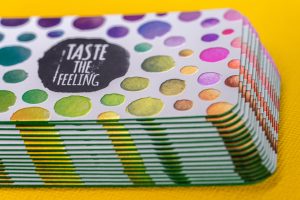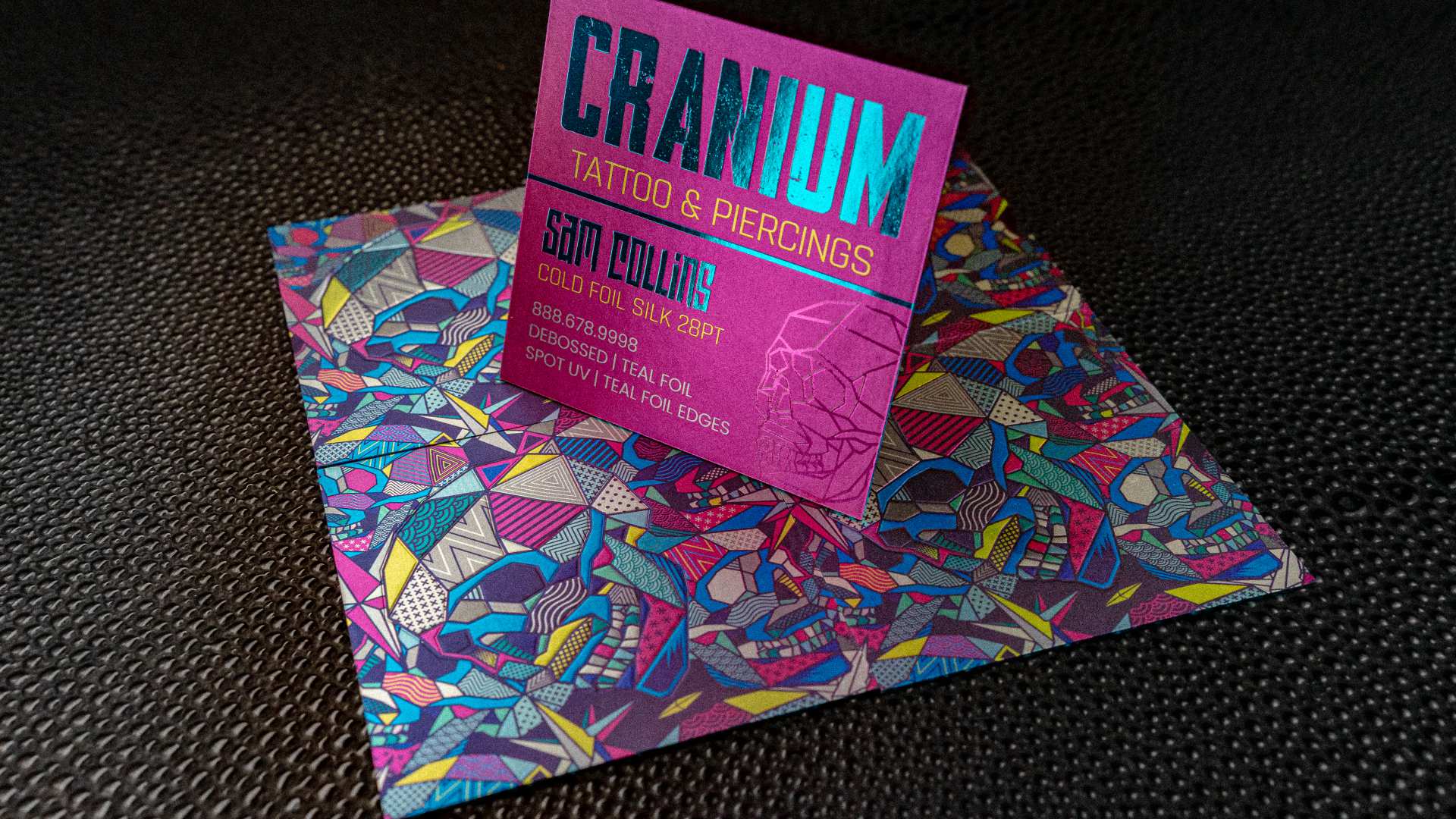Both cold foil and hot foil business cards do one thing very well: attract attention. It’s an effective method for catching the eye and getting noticed. Humans are naturally attracted to things that shine and sparkle as it draws us in and makes us take a closer look. Foil adds an aesthetic of higher quality materials, increasing the perceived value of your brand, ultimately leading to a more positive brand association.
When it comes to business cards, foil stamping techniques can make a significant impact. The choice between hot foil stamping and cold foil printing depends on various factors, including design flexibility, visual impact, durability, production efficiency, and environmental considerations.
Understanding Foil Stamping Techniques
Foil stamping is a decorative process that involves the application of a thin metallic foil onto a surface, such as a business card, to create a visually appealing effect. Both have their own distinct advantages depending on what you’re looking for.
The Basics of Hot Foil Stamping
Hot foil business cards are a popular choice for adding a touch of luxury. The process involves the use of heated die presses to transfer metallic foil onto the card. The die is custom-made based on the desired design and is heated to a specific temperature.
During the hot foil stamping process, the foil is placed between the heated die and the card. When pressure is applied, the heat activates the adhesive on the back of the foil, causing it to stick to the card. Once the pressure is released, the foil remains on the card, creating a metallic finish.
Hot foil stamping allows for precise and intricate designs, as the heated die can capture even the smallest details. It is commonly used for adding silver foils to business cards, giving them a sophisticated and professional look. The metallic foil used in hot foil stamping comes in a variety of finishes, including matte, glossy, and holographic, allowing for further customization options.
How Cold Foil Printing Works
Cold foil printing, also known as cold foil stamping, is a modern technique that offers more design flexibility compared to hot foil. In cold foil printing, the foil is applied inline on press, allowing for greater control and customization options with cold foil business cards.
The process of cold foil printing starts with the application of a UV-curable adhesive onto the substrate. This adhesive is printed in the desired design or pattern, similar to how ink is printed. The foil is then pressed onto the adhesive, and when exposed to UV light, the adhesive cures and bonds the foil to the substrate.
One of the key advantages of cold foil printing is the ability to overprint on top of the foil. This means that designers can create a full range of colors by printing CMYK or other inks on the foil. It also allows for the creation of metallic gradients and the integration of foil into images. Cold foil printing offers greater design flexibility and opens up a world of creative possibilities for business card designs.
Comparing the Visual Impact
Both hot foil stamping and cold foil printing have their unique advantages in making special business cards.. The aesthetic differences between hot foil stamping and cold foil printing can significantly impact the overall look and feel of your business cards.
Shiny Hot Foil

Hot foil stamping offers a classic and luxurious look with its rich metallic finish. The heat and pressure used in the process create a smooth and shiny surface that catches light and adds a touch of sophistication to business cards, making them a popular choice for high-end brands and businesses and creative artists that need to shine.
Colorful Cold Foil

Cold foil printing allows for more versatility in terms of design and color options. It offers the possibility of creating metallic gradients, overprinting on top of the foil with different colors, and integrating foil into images. This opens up a whole new realm of creativity for business card designs, allowing for unique and eye-catching visuals. From metallic blues and greens to bold and eye-catching shades, the possibilities are endless with cold foil printing.
Technical Aspects of Foil Stamping
Apart from the visual impact and aesthetics, it’s essential to consider the technical aspects of foil stamping techniques when choosing the right foil for your business cards. Two crucial factors to consider are durability and the production process.
Durability of Hot vs Cold Foil on Business Cards
There is no durability difference between the two foiling methods. However the paper stock that is used becomes less heavy, due to the foil layer that does not have as much heft as normal card stock. This, if stretched, can correlate to less durability for cold foil.
The foil layer is also softer than a standard card. The softness is less forgivable to mishandling and scratches can show up a little more easily. The layer of cold foil sits before the lamination, protecting it. Stamped foil, however, lays on top of the lamination. Though less durable than standard cards, this process adds protection so your foil printed business cards stand the test of time.
Speed and Efficiency of the Production Process
Cold foil printing takes longer than hot foil stamping because there are additional steps involved in the printing process.
Stamped foil can be added to a standard card or a cold foil card. All cold foil cards have two layers so additional time is needed to get both layers adhered together.
Not all hot stamped foil cards have multiple layers. As such, the turnaround time can be shorter or just as long as a cold foil card, depending on the custom options for your foil business cards.
Industries That Benefit Most from Foil Cards
Foil business card printing techniques can benefit various industries, but there are certain sectors where the visual impact and perceived value of foil-stamped business cards are especially valuable.
Luxury Brands and High-End Services
Luxury brands and businesses that offer high-end services can greatly benefit from the use of foil stamping techniques on their business cards. The luxurious and sophisticated look achieved through hot foil stamping adds a touch of elegance and exclusivity to the brand. Business cards can be seen as a representation of the brand’s quality and attention to detail, making foil-stamped cards an ideal choice for luxury brands.
In the cosmetics industry, where packaging plays a significant role in attracting customers, foil-stamped business cards can create a memorable first impression. The shiny and reflective surface of foil or metallic ink adds a sense of luxury and glamor, aligning perfectly with the aesthetic of high-end cosmetic brands.
Executives and Professionals
C-suite executives and professionals across industries can leverage the power of foil-stamped business cards to make a lasting impression. The use of hot foil stamping or cold foil printing can help elevate their business and personal brand.
For professionals attending high-profile meetings or networking events, handing out a foil-stamped executive business card sets them apart and communicates confidence and attention to detail. The tactile experience and visual appeal of foil-stamped cards make them memorable in a sea of standard business cards, ensuring that the executive’s contact information stands out.
Tattoo Studios
In the world of tattoo studios, where creativity and aesthetics reign supreme, incorporating foil stamping techniques into business cards adds a unique and eye-catching element. By opting for hot or cold foil printing, tattoo artist business cards can achieve a modern and innovative look that resonates with their artistic style.
Foil-stamped business cards for tattoo studios can serve as mini art pieces, reflecting the talent and creativity of the artist. The metallic accents created through foil stamping can mimic the sheen of tattoo ink, creating a visually striking representation of what the studio has to offer.
Creative Industries and Personal Branding
In creative industries such as graphic design, photography, and art, the visual impact of business cards is essential for personal branding. Foil stamping techniques like cold foil printing offer creative professionals the opportunity to showcase their unique style and creativity. By incorporating metallic gradients, overprinting with different colors, and integrating foil into images, designers can create visually stunning business cards that reflect their artistic vision.
Customization Options
Customization is a crucial aspect of business cards, as they represent the unique identity and branding of a business or individual. This is especially true with the customization options available with cold foil vs hot foil stamping for business cards.
Design Flexibility of Hot and Cold Foil
Hot foil stamping is more eye-catching and offers greater flexibility with its ability to create intricate and precise designs. With custom-made dies, designers can achieve highly detailed and unique patterns on business cards. The use of metallic foils adds a touch of elegance and sophistication.
Cold foil printing takes design flexibility to the next level by allowing for even more intricate and versatile designs. From metallic gradients and overprinting with different colors to integrating foil into images, cold foil printing offers endless possibilities for creative and visually striking business card designs.
In the world of foil stamping for business cards, the difference between hot foil and cold foil is significant. While both have their strengths, the decision ultimately depends on your specific business needs and brand image. Consider factors like visual impact, durability, production efficiency, and environmental concerns when making this choice.
By understanding the technical aspects and creative possibilities of each technique, you can make an informed decision that aligns with your brand’s goals. Whether you opt for the timeless elegance of hot foil or the modern flexibility of cold foil, your business cards are sure to make a lasting impression.

